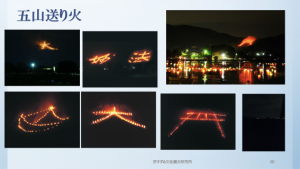Uppercase Okuribi and pine, mysterious energy
Yoshie Doi

![]()
The Kyo-Suzume Culture and Tourism Research Institute logo is designed with the Chinese character for Kyoto. The mountains are marked with red letters.
This year, on August 16th, the Gozan Okuribi was held to conclude the Obon festival. Pine is used for the fire of Daimonji Okuribi. Pine needles are also used. The tar of pine needles has an essential oil component, and it seems that the calorie of combustion is also high.
It has long been known in China that pine needles prevent blood clots, and the medicinal properties of pine needles have been recognized. The effect is described in Chinese medical books, and the essential oil component of pine needle tar activates capillaries, strengthens blood vessels, and is said to have the effect of preventing clots and arteriosclerosis.
Even now, some people say that putting pine needles in their pockets or chewing on pine needles gives them energy. It seems that pine trees have been a symbol of vitality since ancient times. Chewing pine needles while meditating makes them feel energized. Since ancient times, pine needle tea has been said to be effective for detoxification. There are also people who make jam from blue pine cones and eat them.
I didn’t know much about this aspect of pine, but when I looked into natural remedies that boost immunity during the corona crisis, I found that pine needle tea was so popular that it was sold out and couldn’t be bought.
The wood used for Okuribi at Gozan seems to differ from mountain to mountain, and the color of the fire seems to be different. The Gozan Okuribi is said to have a history of about 500 years since the Muromachi period, but when Western civilization entered after the Meiji Restoration, the Gion Festival to ward off plague gods and the Daimonji Okuribi to send off the spirits of ancestors became superstitions. Well, there was a time when it was banned for 10 years.
The idea that when a person dies, his soul leaves his body, climbs to the top of a mountain, and becomes a mountain god over a long period of time, has developed into the idea of the Yamanaka Jodokan under the influence of Buddhism. And even now, the event of Daimonji Okuribi (Gozan Okuribi) is used to send the spirits of the Obon festival back to the other world.
Our Kyo-Suzume activities are also related to fire. We hold the Okudosan Summit every year. When researching and considering history and culture from the perspective of the culture of fire, Yasaka Shrine’s Wokera-mairi has the effect of burning a tree called Wokera with fire to ward off evil spirits and sterilize mold and bacteria in the air. The idea of resetting the spark in the new year is also Japanese. It seems that the custom of smoking kimonos with wokera still remains today, but I would like to pass on the splendor of the natural world to the next generation. I am keenly aware that there are many things that can be explored if the original natural world and human beings are prepared.
In the future activities of Kyo-Suzume, I would like to develop the Kyoto Study Project, which explores culture and history from a three-dimensional perspective.
The end of document
